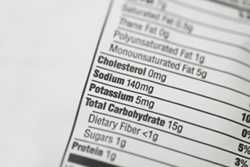How to Reduce Sodium

Sodium content in the same food can vary widely depending on how it has been processed.
For most people, when sodium intake is reduced, blood pressure begins decreasing in only a few weeks, on average.1
Choose a Heart-Healthy Diet
The DASH (Dietary Approaches to Stop Hypertension) eating plan is a simple, heart-healthy diet that can help prevent or lower high blood pressure. The DASH diet is low in sodium, cholesterol, and saturated and total fats, and it is high in fruits and vegetables, fiber, potassium, and low-fat dairy products.
If you follow the DASH eating plan and also make other lifestyle changes, such as getting more physical activity, you will see the biggest benefits. Learn more about the DASH eating plan on the National Heart, Lung, and Blood Institute’s Web site.
If everyone reduced the amount of sodium in their diet by 1,200 mg per day, up to 99,000 heart attacks and 66,000 strokes could be prevented in the United States every year.2
Decoding Nutrition Labels

Reading the Nutrition Facts label on packaged foods can show you the amount of sodium per serving. Don’t forget to check the number of servings per container!
Tips for Lowering Sodium at the Supermarket
- Buy fresh, frozen (no sauce), or no salt added canned vegetables.
- Use fresh poultry,* fish, pork,* and lean meat, rather than canned or processed meats.
- When available, buy low sodium, lower sodium, reduced sodium, or no salt added versions of products.
- Limit your use of sauces, mixes, and “instant” products, including flavored rice and ready-made pasta.
- Compare Nutrition Facts labels on food packages for Percent Daily Value or amount of sodium in milligrams.
* Check to see if saline or salt solution has been added—if so, choose another brand.
Tips for Lowering Sodium While Eating Out
Restaurant foods are a major source of sodium in most Americans' diets, so it pays to take a few minutes to find out what’s in the food you're eating. Planning ahead also can help you find restaurants that have information on sodium levels in the foods they serve.
To reduce your sodium when you are eating out at a restaurant:
- Check online for nutritional information before you go if you are eating at a chain restaurant or fast-food outlet. Some independent restaurants also post this information on their Web sites.
- Ask your server for information about the amount of sodium in your food. Sometimes this information is printed on the menu.
- Request that no salt be added to your food.
- Beware of hidden sources of sodium such as sauces and dressings, and ask for these toppings on the side.
References
- Chobanian AV, Bakris GL, Black HR, Cushman WC, Green LA, Izzo JL Jr, et al. Seventh report of the Joint National Committee on Prevention, Detection, Evaluation, and Treatment of High Blood Pressure. Hypertension. 2003;42(6):1206–52.
- Bibbins-Domingo K, Chertow GM, Coxson PG, Moran A, Lightwood JM, Pletcher MJ, et al. Projected effect of dietary salt reductions on future cardiovascular disease. N Engl J Med. 2010;362(7):590–9.
- Page last reviewed: August 21, 2014
- Page last updated: August 21, 2014
- Content source:



 ShareCompartir
ShareCompartir